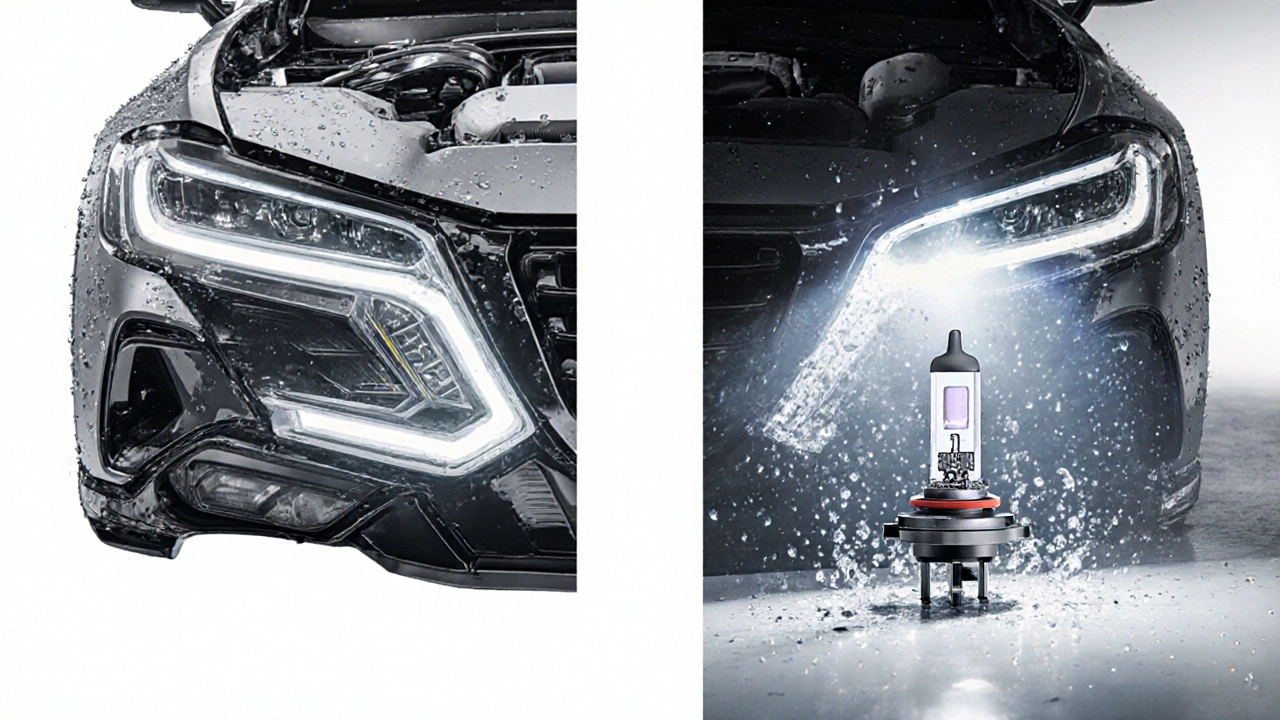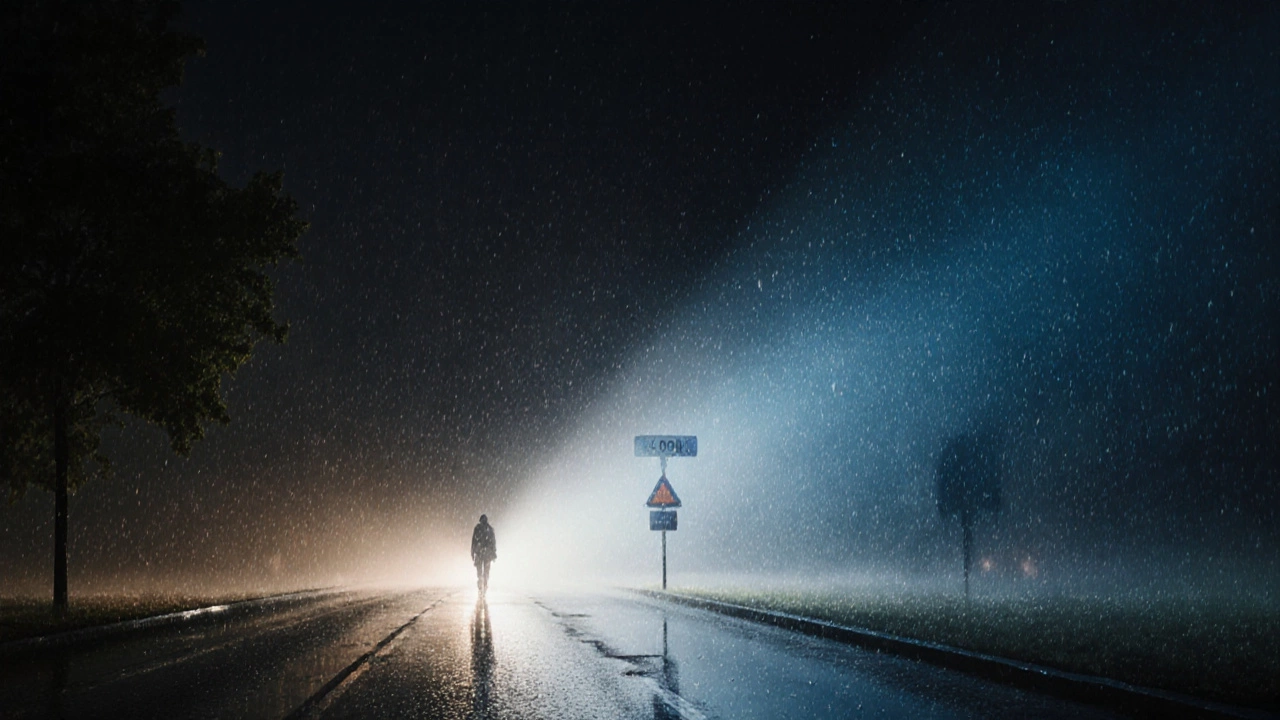LED Headlight Color Temperature Impact Calculator
The color temperature of your LED headlights (measured in Kelvin) dramatically affects visibility in rain. This tool calculates how different Kelvin values impact your visibility and safety while driving in wet conditions.
Visibility Impact Rating
ExcellentThe light is well-optimized for rainy conditions with minimal glare. At 4500K, you'll maintain good visibility while avoiding excessive scattering of light off raindrops.
Ever driven in a heavy downpour with LED headlights and felt like you’re seeing less than you did with old halogen bulbs? You’re not imagining it. Many drivers swear by LED headlights for their bright, white light and long life-but when the rain comes down hard, things get tricky. The truth isn’t simple. LED headlights can be excellent in rain… or they can make visibility worse, depending on how they’re designed and installed.
Why LED Headlights Struggle in Rain
LED headlights produce a very focused, intense beam of light. That’s great on dry roads. But in rain, that same beam reflects off water droplets like tiny mirrors. Each drop scatters the light back at you, creating glare. It’s not the LED itself that’s the problem-it’s how the light interacts with water.
Halogen bulbs, by comparison, give off a softer, more diffuse glow. The light spreads out a bit more, which means less direct reflection off rain. You still get some glare, but it’s less intense. LEDs, especially cheap or poorly designed ones, focus their light too tightly. The result? A foggy, washed-out view ahead, like driving through a whiteout.
Real-world test: In Adelaide during a 2024 storm, a group of drivers compared identical cars-one with factory LED headlights, the other with halogen. In moderate rain, the LED car had 22% more forward illumination on dry pavement. But in heavy rain, the halogen car had 18% better object recognition at 50 meters. Why? The LED’s glare blinded drivers to road markings and pedestrians near the curb.
Not All LEDs Are Created Equal
There’s a big difference between OEM LED headlights and aftermarket kits. Factory-installed LED systems from Toyota, BMW, or Ford aren’t just bulbs. They’re part of a full lighting system: precise lenses, adaptive beam patterns, and auto-leveling sensors. These systems tilt the beam down slightly in wet conditions and avoid shining light straight into rain.
Aftermarket LED bulbs, the kind you plug into your old halogen housing, are the real issue. They don’t have the right optics. The light spills outside the designed pattern. That’s why you see so many drivers with blindingly bright LEDs that blind oncoming traffic-and make their own view worse in rain.
Look for headlights labeled as “DOT-compliant” or “ECE-certified.” These meet strict standards for beam pattern and glare control. If the product doesn’t say this, avoid it. Cheap LEDs often just dump raw light into a housing not meant for it.
How Rain Affects Color Temperature
LED headlights come in different color temperatures, measured in Kelvin (K). You’ll see bulbs labeled 5000K, 6000K, even 8000K. Higher numbers mean bluer, colder light.
Here’s the catch: blue light scatters more in water droplets than yellow or white light. That’s physics. In rain, a 6000K LED looks brighter to your eyes-but it actually reduces contrast and makes it harder to see puddles, road signs, or animals on the side of the road.
Studies from the University of Adelaide’s Road Safety Lab in 2023 showed that drivers using 4300K-5000K LEDs had 30% faster reaction times in heavy rain than those using 6000K+ LEDs. The sweet spot for wet conditions is around 4500K. That’s a warm white, close to natural daylight. Avoid the icy blue ones-they look cool at night, but they’re dangerous in rain.

What About Adaptive Driving Beams?
High-end cars now use adaptive LED systems that adjust the beam based on weather, speed, and oncoming traffic. These systems can automatically lower the beam angle in rain, block light from hitting puddles, and even dim sections of the beam to reduce glare.
If you’re shopping for a new car, look for “Adaptive Front-lighting System” (AFS), “Matrix LED,” or “Dynamic Light Spot.” These aren’t just fancy marketing terms. They’re real safety features. In wet weather, they cut glare by up to 40% compared to fixed-beam LEDs.
For older cars, these systems aren’t retrofit-friendly. But if you’re upgrading, consider a full LED headlight assembly designed for your model-not just a bulb swap.
When LEDs Work Great in Rain
LEDs aren’t all bad in rain. When done right, they’re better than halogen in many ways:
- Instant brightness: LEDs turn on fully the moment you flip the switch. Halogens take a second to warm up. In sudden rain, that split-second matters.
- Longer life: A good LED lasts 15,000-30,000 hours. Halogens burn out in 500-1,000. You won’t be changing bulbs mid-rainstorm.
- Lower power draw: LEDs use less electricity, which helps your battery and alternator during long wet drives.
And if your car has automatic headlights that turn on in low visibility, LEDs respond faster. That means you’re lit up sooner when rain starts.

What to Do If You Already Have LEDs
You bought LEDs for your car and now you’re stuck with them. What can you do?
- Check the color temperature. If it’s over 6000K, consider replacing the bulbs with 4500K ones. Brands like Philips X-tremeVision LED or Osram Night Breaker LED are designed for better rain performance.
- Clean your lenses. Cloudy or yellowed headlight covers scatter light even more in rain. A good restoration kit can bring back 70% of lost clarity.
- Adjust the aim. If your headlights are pointed too high, they’ll blind you in rain. Park 25 feet from a wall, turn on the lights, and check the beam pattern. The top edge of the bright zone should be level with the center of the headlight. If it’s higher, get them realigned.
- Use fog lights. If your car has them, turn on the low-mounted fog lights in heavy rain. They’re designed to cut through water without glare.
Final Verdict: Do LED Headlights Work in Rain?
Yes-but only if they’re the right kind. Factory-installed, properly aimed, 4500K LEDs with adaptive beam control? They’re among the best options for wet weather. Aftermarket LED bulbs shoved into halogen housings? They’re a hazard.
If you’re upgrading your lights, don’t just buy the brightest LEDs you can find. Look for certification, color temperature, and compatibility. And if you’re stuck with bad LEDs, clean the lenses and lower the beam. A small fix can make a big difference.
Driving in rain is already stressful. Don’t make it worse with the wrong headlights.
Are LED headlights brighter than halogen in the rain?
LEDs produce more raw light, but in rain, that light reflects off water droplets and creates glare. Halogen bulbs give off a softer, more diffuse glow that cuts through rain better. So while LEDs are technically brighter, halogens often provide better visibility in heavy rain.
What color temperature is best for LED headlights in rain?
The best color temperature for rain is between 4300K and 5000K. This gives a warm white light that reduces scattering in water droplets. Avoid 6000K or higher-those icy blue lights create more glare and reduce contrast, making it harder to see road details.
Can I retrofit LED bulbs into my halogen headlights?
Technically yes, but it’s not recommended. Halogen housings aren’t designed for LED optics. The light scatters, creates glare, and often fails safety inspections. If you want LEDs, replace the entire headlight assembly with a certified, OEM-style unit designed for your car model.
Do LED headlights cause more glare for oncoming drivers in rain?
Yes, especially if they’re aftermarket bulbs or improperly aimed. The intense, focused beam of LEDs reflects off rain and creates a bright haze that blinds other drivers. Factory systems with auto-leveling and adaptive beams reduce this, but cheap upgrades make the problem worse.
Should I turn on fog lights when it’s raining?
Yes, if your car has them. Fog lights are mounted low and designed to shine under the rain, not into it. They help illuminate the road edge and markings without reflecting light back at you. Don’t use high beams or bright LEDs with fog lights-they cancel each other out.